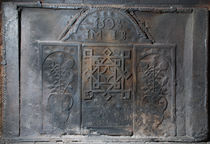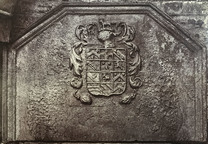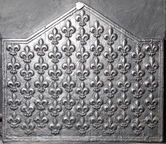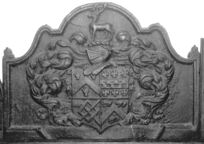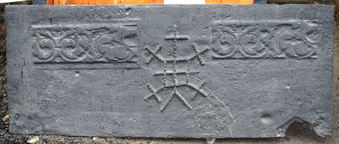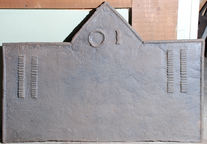-
914
Description: Rectangular shape; twisted rope edging (top and sides) with fillet edging at bottom; cast of a 1598 fireback within a recessed panel, the arch of the original fireback being overlaid with twisted rope and diagonal lengths of rope laid alongside. The original fireback is described as follows: Composite of three elements; central panel has a complex ‘knot’ pattern with a fillet edge; side panel, repeated on either side of the central panel, contains a vase of flowers, possibly stylised thistles, within an arched frame and fillet edge; arched panel above, also with fillet edge, contains the date and inscription; the spandrels of the side panels, and the arched top panel, contain a series of 'bullseye' motifs comprising concentric rings deepening towards the centre.
Notes: The central fireback measures 795mm wide by 735mm high and is from a different casting to that seen at Linchmere, Sussex (no. 475).
Inscription: 1598 / IM IB
- Decoration tags:
- rectangular (shape)
- rope (edging)
- composite
- planklines
- text
- plants
- objects
Manufactured: in the late-16th to early-17th century in the Weald area of England.
Current location: Goddards, Abinger Common, Abinger, Surrey, England.
- Attached to series:
- Armada series
- Composite firebacks
- Garden design types
-
1034
Description: Canted rectangular shape; twisted rope edging in short lengths (top and sides); shield stamp with rebated edges repeated five times (two and three).
Notes: The arms are those of Courthope of Whiligh in Ticehurst; blazon: argent, a fess azure between three estoiles sable (two and one). Shown are molets of six points which have straight rays instead of (properly) estoiles which have wavy ones. However, the 1643/4 iron graveslab of David Barham of Snape, in Wadhurst church, has the same arms (also with molets instead of estoiles), which were those of his mother who was a Courthope.
Arms: Courthope, of Whiligh in Ticehurst
- Decoration tags:
- rectangular with canted top corners (shape)
- rope (edging)
- carved stamps
- heraldic
- armorial
Manufactured: in the late-16th to early-17th century in the Weald area of England.
Current location: Fulham, London, England.
- Attached to series:
- Personal armorial firebacks
- Courthope arms series
-
335
Description: Canted rectangle; stepped edging; unidentified shield with 12 quarterings, helm and crest; arms carved on rectangular back board.
Notes: Two horizontal plank lines; arms over-stamped. Photographed at Messrs. C. Pannett & Sons, Highgate, Hawkhurst, Kent; from an album of photographs of firebacks by W. Galsworthy Davie c.1912 (National Art Library, Victoria and Albert Museum, London).
Copies of this fireback are known.
Arms: Not known
- Decoration tags:
- rectangular with canted top corners (shape)
- rebated fillet (edging)
- carved pattern panels
- planklines
- armorial
Manufactured: in the late-16th to early-17th century possibly in the Weald area of England.
Current location: not known.
Citation: Shuffrey, L. A., 1912, The English Fireplace, London, Batsford.
- Attached to series:
- Personal armorial firebacks
-
1101
Description: Rectangular arrangement with fillet edging of eight square panels (four over four) between moulded stiles.
Notes: The pattern for this fireback suggests that it was made from a section of panelling, perhaps fitted into a frame for rigidity.
- Decoration tags:
- rectangular (shape)
- fillet (edging)
- carved pattern panels
- architectural
Manufactured: in the late-16th to early-17th century possibly in the Weald area of England.
Current location: Sackville College, Church Lane, East Grinstead, West Sussex, England.
- Attached to series:
- Miscellaneous pattern firebacks
-
71
Description: Fragment; upper half of an arched rectangular shaped fireback; fillet edging; divided into two halves; left half - naked female figure of Truth holding scales in right hand, surrounded by motto ribbon bearing the text: HET IS V EEN SCHADE DAT TROVE IS LICHTER DAN EEN PLV; right half - naked female figure of Vigilance, a bird seated on her right hand, and with two dogs on leads held in her left hand, surrounded by a motto ribbon bearing the text: ICH IAGE OM DIE VINDEN OFT ICH TROVE KONDE VINDEN; initials between scales; date divided by cross of an orb forming the centre of the four intended panels.
Notes: The complete fireback has four figures (clockwise from top left) representing Truth, Vigilance (both naked), Indifference and Perfidy (both clothed).
Copies of this fireback are known.
Inscription: SG 1598 HET IS V EEN SCHADE DAT TROVE IS LICHTER DAN EEN PLV / ICH IAGE OM DIE VINDEN OFT ICH TROVE KONDE VINDEN
- Decoration tags:
- rectangular with round arch (shape)
- fillet (edging)
- whole carved pattern
- individual numbers
- allegorical
- text
- animals
- humans
- objects
Manufactured: in 1598 possibly in the Lorraine area of Germany.
Current location: Godalming Museum, Godalming, Surrey, England.
Museum number: B980.407 (part of the Godalming Museum museum group)
- Attached to series:
- Virtues and Faults firebacks
-
88
Description: Rectangular with triangular arch; stepped fillet edging; eleven columns of fleurs de lys, maximum seven in column, but varied according to space, with fleurs alternated for spacing.
Notes: Whole pattern with five vertical planklines; a field of small fleurs de lys, France Ancient in royal heraldry, might suggest a continental origin.
Copies of this fireback are known.
- Decoration tags:
- rectangular with triangular arch (shape)
- stepped fillet (edging)
- whole carved pattern
- planklines
- heraldic
- objects
Manufactured: in the late-16th to early-17th century possibly in the Weald area of England.
Current location: Hampton Court, Richmond, Greater London, England.
- Attached to series:
- Miscellaneous royal firebacks
- Fleur-de-lys firebacks
-
144
Description: Quasi-arched rectangular shaped with cyma recta curved shoulders and 'pinnacles'; ovolo moulded edging with a deep base panel; shield, helm, crest and mantling of the Maynard family; plain motto scroll below.
Notes: The arms, which are those of an esquire, can be identified from the first four quarters on the memorial to Raffe Maynard, d.1613, in St Albans Cathedral, son of John Maynard (d.1556); quarterly, 1, Maynard: argent, a chevron azure between three sinister hands couped at the wrist gules; 2, Filleigh: gules, a fess vairy between six crosses formy or; 3, Hewis: gules fretty argent a canton of the second; 4, Lyons: argent a chevron sable between three lions dormant coward gules; the crest, a stag statant, is of Maynard. Contemporaneously, there were Maynards who operated ironworks in the Rotherfield area in Sussex, with whom this fireback may be connected. Significantly the motto scroll is blank, suggesting that the wooden pattern for the fireback had been originally intended as a decorative panel with the motto painted rather than carved in relief. The top right corner of the shield was evidently broken on the original pattern prior to being impressed into the casting sand to form the mould. A smaller casting with the same arms is also known (no. 667). Formerly part of the Ade Collection (from Grove Hill, Hellingly, Sussex).
Copies of this fireback are known.
Arms: Maynard family
- Decoration tags:
- rectangular with round arch (shape)
- ovolo (edging)
- whole carved pattern
- armorial
Manufactured: in the late-16th to early-17th century in the Weald area of England.
Current location: Hastings Museum and Art Gallery, John's Place, Bohemia Road, Hastings, East Sussex, England.
Museum number: HASMG: 1952.51.14 (part of the Hastings Museum museum group)
-
165
Description: Rectangular with low, 3-facetted arch; ovolo edging; shield of the Goldsmiths’ Company: quarterly Gules and Azure, in the first and fourth quarters a Leopard's Head affrontée Or, in the second and third quarters a Covered Cup between in chief two Buckles fesswise all of the last; behind the shield is a scrolled escutcheon.
Notes: An unusually thick fireback. The Goldsmiths’ Company were granted arms in 1571.
Copies of this fireback are known.
Arms: Worshipful Company of Goldsmiths
- Decoration tags:
- rectangular with three-facetted arch (shape)
- ovolo (edging)
- whole carved pattern
- armorial
Manufactured: in the late-16th to early-17th century possibly in the Weald area of England.
Current location: Hastings Museum and Art Gallery, John's Place, Bohemia Road, Hastings, East Sussex, England.
Museum number: HASMG: 1978.15 (part of the Hastings Museum museum group)
- Attached to series:
- Livery company firebacks
-
174
Description: Rectangular; plain plate with central crossed-square rope pattern with crosses at the corner and top; on each side a rectangular stamp with swirled tendril, serpent and demi-cup decoration.
Notes: The crossed square was an alchemistic symbol for iron vitriol (i.e. ferrous sulphate or copperas), but the crosses at the extremities may indicate other symbolism or none; similar patterns are found on other firebacks of a group that may have been associated with Pounsley furnace, Sussex. The repeated panel at the top appears to have been formed using a mould for a section of a plasterwork frieze, resulting in an intaglio impression (approx 395 x 142mm or 15½ x 5½ in.) as opposed to the normal bas-relief; this is very unusual on a fireback. The style of the mould dates from the Elizabethan or Jacobean period. The stubs on the bottom edge are likely to have been the remains of runners where the molten iron entered the mould. Recovered from a property in Burwash, Sussex, in 1910.
- Decoration tags:
- rectangular (shape)
- none (edging)
- simple stamps
- apotropaic
- animals
- objects
Manufactured: in the late-16th to early-17th century possibly at Pounsley Furnace, Framfield in the Weald area of England.
Current location: Hastings Museum and Art Gallery, John's Place, Bohemia Road, Hastings, East Sussex, England.
Museum number: HASMG: 1910.26.1 (part of the Hastings Museum museum group)
Citation: Baines, J. M., 1958, Wealden Firebacks (Hastings Museum).
- Attached to series:
- Pounsley series
- Miscellaneous stamp firebacks
-
333
Description: Rectangular with triangular extension at middle of top edge; rope edging (top and sides); inscription in triangle - O larger than I; a pair of vertical, parallel ratchet bars (180mm long) below each top corner.
Inscription: O I
- Decoration tags:
- rectangular with triangular arch (shape)
- rope (edging)
- simple stamps
- text
- objects
Manufactured: in the late-16th to early-17th century possibly in the Weald area of England.
Current location: Horsham Museum, Causeway, Horsham, West Sussex, England.
(part of the Horsham Museum museum group)
- Attached to series:
- Miscellaneous stamp firebacks
